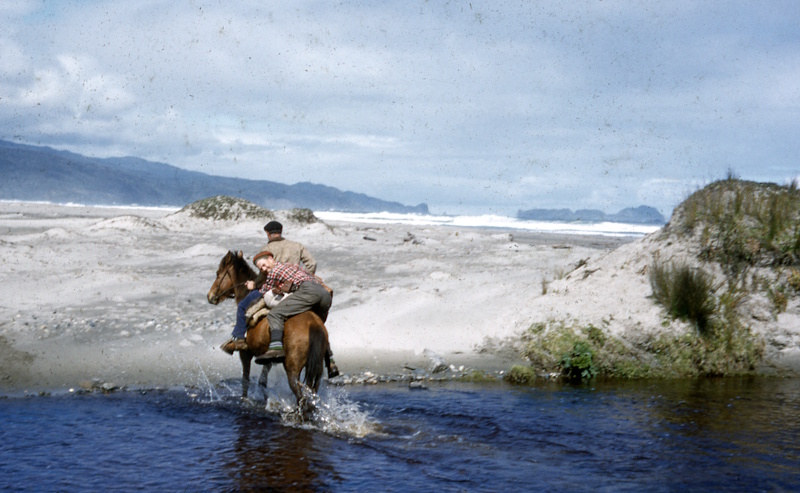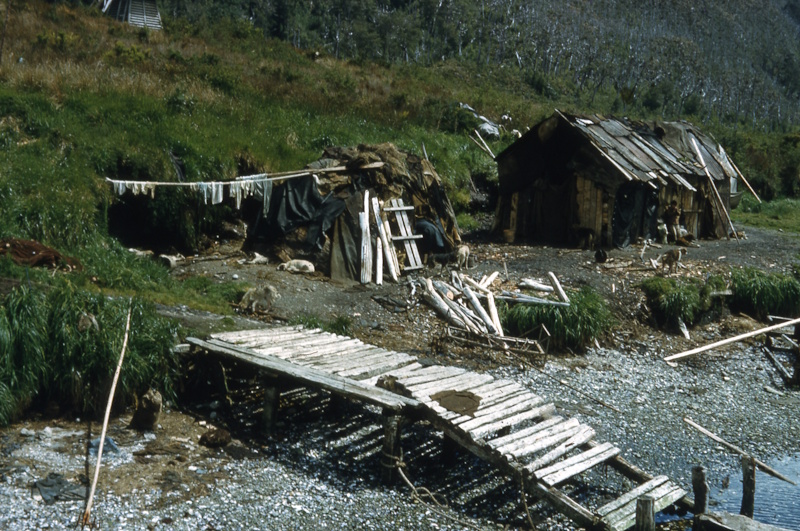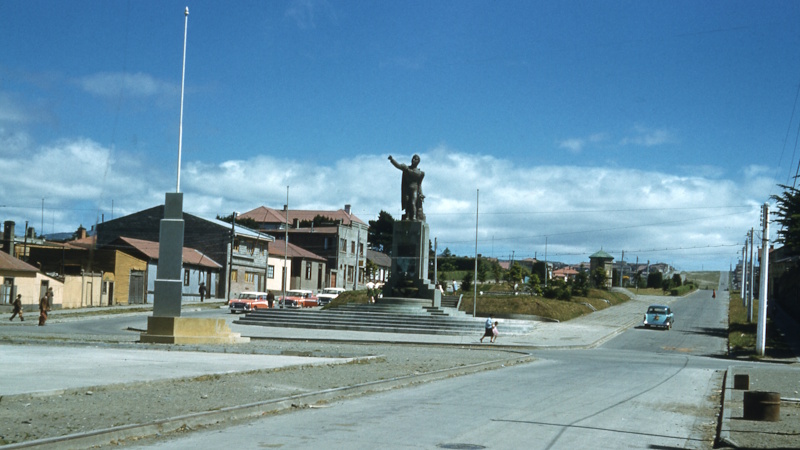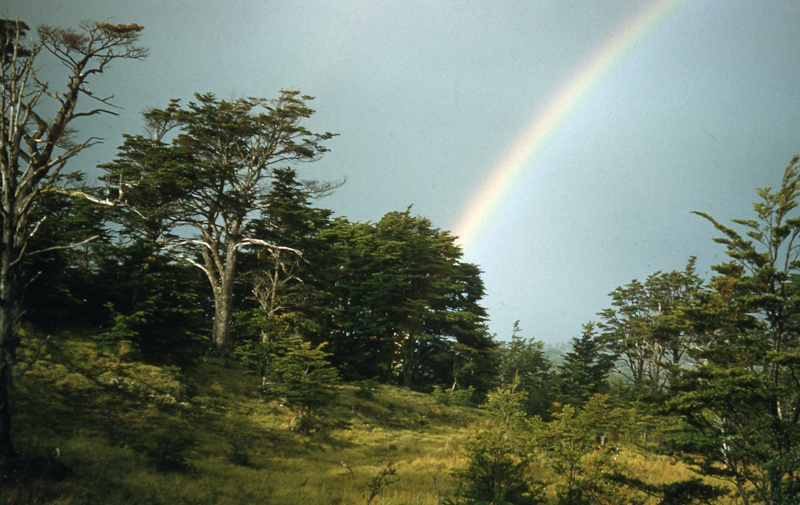Ainsley Vinall highlights a collection of photographic slides from the 1958-59 Royal Society expedition to Southern Chile, recently added to the Society's collections.

Over the last few weeks, I’ve been cataloguing a collection of over 300 photographic slides from the Royal Society expedition to Southern Chile, which took place from September 1958 to March 1959. The slides were donated in July 2024 by Sir Martin Holdgate (b.1931), who acted as the expedition leader. He took the vast majority himself, and donated his field notebooks, expedition diary and some objects collected during the trip.
The expedition was planned to coincide with the centenary of On the origin of species, the seminal work on evolutionary biology by Charles Darwin FRS (1809-1882) first published in 1859. Originally an extensive trip around the Southern Temperate Zone was suggested, tracking the voyage of HMS Beagle that took the young Darwin across this part of the world in the 1830s. However, when HMNZS Endeavour, the proposed ship for this voyage, proved unavailable, the stops in Australia, New Zealand and a number of smaller islands were cut, shifting the expedition to a detailed study of Southern Chile.
Five scientists were chosen for the expedition, selected to represent their individual fields of study and their respective nations. British zoologist Martin Holdgate was joined by botanist Eric Godley (1919-2010), marine biologist George Knox (1919-2008) and geologist William Watters (1926-2014) from New Zealand, as well as entomologist Guillermo Kuschel (1918-2017) from Chile.
 George Knox fording a river on horseback, 1958 (MS/955/6/37)
George Knox fording a river on horseback, 1958 (MS/955/6/37)
The expedition photos begin in Santiago in September 1958 where the party assembled and made contact with the British Council and the Chilean Air Force. Undeterred by the delayed passage of their supplies through customs, the group made a short excursion to the Andes while they waited, exploring the mountains on horseback. Once their packages were released, they travelled down to Puerto Montt by train and then flew to the first research site, Chepu on the west coast of Chiloé Island.
As well as reassessing sites visited by Darwin, the Southern Chile expedition also aimed to investigate species common to New Zealand, Australia and South America. In the 1950s, geological concepts such as plate tectonics were still new areas of research, and there was an active debate about the past configuration of the world’s continents. Expeditions such as this one, which showed how similar flora and fauna occur across the Southern Temperate Zone, helped to inform our modern knowledge about the history of the Earth.
 Eric Godley at the coast near Chepu, 1958 (MS/955/6/55)
Eric Godley at the coast near Chepu, 1958 (MS/955/6/55)
Following an exploration of the shoreline of Chepu, the party ventured further inland to research the nearby rainforests. They were making good progress with their sample collecting by this point, and already had a jar full of anaesthetised sea cucumbers and a large bowl of frogs, which they kept fed on flies.
After five weeks, the group left Chepu and moved on to their next site, the San Pedro Mountain Range at the highest point of Chiloé Island. Here they set up a base in an abandoned sheep farm and spent two weeks identifying species native to the highland forests and grasslands. Before descending to Castro, the capital of Chiloé Province, Kuschel ventured out to hunt a small deer and the party held an asado, a traditional Chilean barbecue.
From Castro the expedition party travelled south by ship to their next research site, Puerto Edén on the east coast of Wellington Island. Known for its extraordinarily wet and humid climate, this destination also brought the scientists into contact with a small population of indigenous Kawésqar people. Based in Puerto Edén for four weeks, the party used their expedition boat to explore the islands on either side of the English Narrows.
 The houses and jetty at Puerto Edén, 1958 (MS/955/6/175)
The houses and jetty at Puerto Edén, 1958 (MS/955/6/175)
In addition to recording the local landscapes and wildlife, the party also documented the daily life of the Kawésqar residents of Puerto Edén. These photographs provide a fascinating insight into a group of people with cultures and customs distinct from the majority of South America, including their 15ft boats, made from the trunks of southern beech trees, and their housebuilding and local crafts.
When the Chilean ship Micalvi passed through the settlement, the expedition party came aboard and began their voyage down to Punta Arenas, celebrating Christmas with the ship’s crew on Guarello Island. Arriving in Punta Arenas, they were dismayed to hear that their Christmas cards sent from home, as well as a crate of champagne and other delicacies, had been forwarded on to Puerto Edén for them, only to arrive after they had left.
 Avenida Independencia in Punta Arenas, 1958 (MS/955/6/229)
Avenida Independencia in Punta Arenas, 1958 (MS/955/6/229)
After touring some local farms and historic sites near Punta Arenas, they flew to Puerto Williams on Navarino Island, the southernmost town in the world. Here the group explored the nearby coastline and forests before setting up camp in the mountains above the town. They also made a number of excursions to neighbouring islands, visiting Picton Island to the east and Bertrand Island to the south.
 A forest glade on Bertrand Island, 1959 (MS/955/6/288)
A forest glade on Bertrand Island, 1959 (MS/955/6/288)
The photographs from this final part of the expedition are some of my favourites. The islands at the very south of Chile are presented as relatively untouched, compared to the other research sites, with few signs of human habitation. The snow-capped mountains and forest glades create a picturesque view of these distant locations, at the very southern tip of the South American continent.
Upon returning to the UK, the party held a conference to share their findings and published the resulting papers in a special edition of Proceedings B. They also put on an exhibition of their work for a Royal Society conversazione in 1961, photos of which are included in this collection. As a record of both the expedition itself and how these fascinating places looked over 65 years ago, we hope these newly catalogued photographs will be useful to researchers across a range of disciplines; and of course as a record of the local people, and their way of life.






